Tag : Lilith
February 25, 2021 by admin
Keeper of the Flame
Whenever I would see Flory Jagoda, it was as if she had been waiting just for me, greeting me with her lovely smile and sparkling eyes. Often, she would say, “Here you are!” And now that she could kiss me–always on both cheeks–and hold my hand tightly, she seemed happy. I know I certainly was.
The truth is, Flory greeted pretty much everyone that same way, whether in her home or a concert hall amid hundreds of people there to see her perform. She was one of those few individuals with the remarkable ability to make each person feel truly special and important to her.
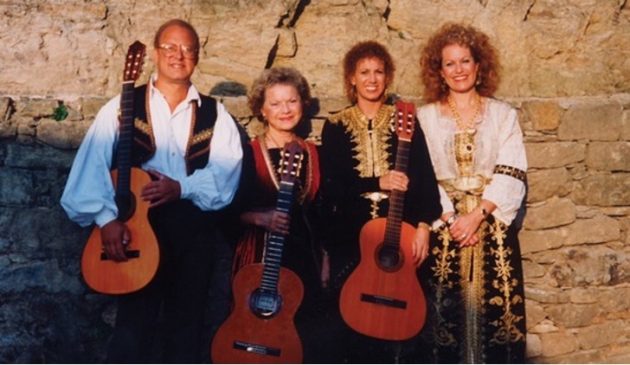
- No Comments
February 19, 2021 by Sarah M. Seltzer
An Open Letter from Vashti to Her Successor
Dear New Queen,
If you are reading this, I am long gone. I left the palace behind. I may have even left Shushan. I’m not sure where I will be when you receive this letter, but I’m far away from the king, his ministers, and a life that was never mine. Wherever I am, my story is now my own. I am free.
My name is Vashti. The king sent me away because I refused to dance at his party. As a child, I loved dancing. I spun barefoot circles with my mother and her sisters. My palace was in her arms, her stories were in my ears, and her song was my heartbeat. When I think of dancing, I think of my mother, even though she is long gone too.
(more…)- 1 Comment
February 19, 2021 by admin
Where Are the Jews?
On Friday, February 12–the Lunar New Year, Rosh Chodesh Adar, and Shabbat–the first episode of LUNAR: the Jewish-Asian Film Project premiered, a video series highlighting Asian American Jews. As a mixed heritage Chinese-American and Ashkenazi Jew, I was proud to have been featured.
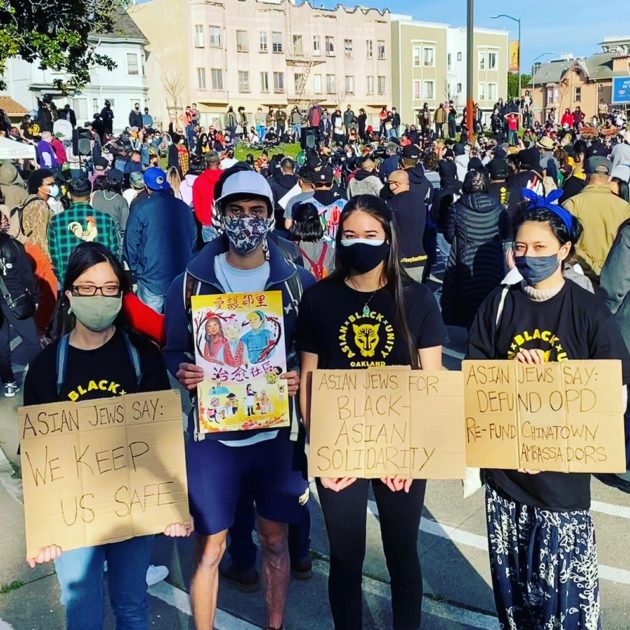
But the sweetness of the New Year was also met with anger and fear. Like many Asian American/Pacific Islanders (AAPI) in the San Francisco Bay Area and across the country, I was horrified to hear about the attacks against Chinese and Vietnamese elders leading up to the New Year. And I was deeply disappointed at mainstream media amplifying these violent events to pit the Black and Asian communities against each other and justify the need for police.
(more…)- No Comments
February 11, 2021 by April Baskin
When Jewish Space Laser Jokes Help the Enemy
Last week, as I was scrolling through Facebook, I noticed all the chatter and jokes about a “Jewish space laser.” It was clear to me that people were responding to a headline. Initially I assumed based on context clues that it was some sort of joke coming from a Jewish leader, or perhaps out-of-context banter about an Israeli space program.
No one’s post directly identified a source, so I went searching to find out for myself. I was a bit surprised and disappointed to learn that it wasn’t “one of our own.” Rather, this absurd antisemitic conspiracy theory was from a November 2018 Facebook post written by Marjorie Taylor Greene, a recently-elected congresswoman and QAnon enthusiast, in which she speculated Rothschild-owned space lasers were the cause of the California wildfires.
(more…)- No Comments
February 10, 2021 by Steph Black
A Reproductive Shabbat
On a Saturday afternoon many months ago, I leaned across the center console of my car and pushed open my passenger side door to welcome in a stranger. I only knew her first name and cell phone number, and that she was having an abortion later in pregnancy.
This was my Shabbat, bringing her back and forth between one of the five clinics that would perform the procedure she needed and the modest hotel a mile away.
(more…)- No Comments
February 3, 2021 by Yona Zeldis McDonough
Forget Russia: a Q&A with L. Bordetsky-Williams
“Your problem is you have a Russian soul,” Anna’s mother tells her. In 1980, Anna is a naïve college senior studying abroad in Moscow at the height of the Cold War. She’s also a second-generation Russian Jew raised on a calamitous family history of abandonment, Czarist-era pogroms, and Soviet-style terror.
Novelist L. Bordetsky-Williams talks to Fiction Editor Yona Zeldis McDonough about how Anna’s experience both illuminates the dark corners of her family’s past and shines a light toward the future she is fashioning for herself.
YZM: You write about Russia with such affection and intimacy; what is your relationship to the country?
(more…)- No Comments
February 2, 2021 by admin
Ten Things to Remember for Black History Month… and Beyond
I love love love Black History Month. I love being intentional about pausing and reflecting on Black beauty, Black joy, and Black resilience, all of which is synonymous with Black history. I love being reminded of the Black food, Black music, and Black wisdom that has sustained us through the generations.
And as Jews prepare for Black History Month observations and celebrations this year I want to invite non-Black Jews to remember some things:
(more…)- No Comments
January 27, 2021 by Sarah M. Seltzer
My Anger at the Kavanaugh Hearings Inspired Me to Take Action
Two years ago, I was walking on the street during the Kavanaugh hearings and noticed that almost every woman I walked by was glued to her phone; their faces reflected my disgust and my fear for the future. The brutality of the hearings, the callous dismissal of Christine Blasey Ford’s accusations, the general smugness of Justice Kavanaugh and his elected supporters knocked me back in a visceral way. I finally snapped.
I needed to channel that frustration and anger into something productive, so I decided to combine that post-Kavanaugh fury with nearly 20 years of work in reproductive health and develop a program to improve access to birth control in rural and underserved communities.
I went down a rabbit hole of research on models for improving access to such care, and found that in rural communities around the world, mobile clinics are a proven means of delivering care directly to healthcare deserts.
Next, I needed the where.
In 2018, four states—Mississippi, Louisiana, South Dakota, and North Dakota—had “trigger laws,” meaning that if Roe v. Wade is overturned, abortion immediately becomes illegal. More states have since joined them in passing similar legislation. Among them, Mississippi has some of the poorest reproductive health and sexual health outcomes in the nation. In the Mississippi Delta, one of the most rural areas in the state, 62% of pregnancies are unintended and publicly funded clinics are unable to meet 60% of women’s needs for reproductive health care. I reached out to institutions and organizations to understand if what seemed like a good idea in my head—using mobile clinics to increase access to care effectively in birth control deserts like the Delta—would work in the reality of rural Mississippi. I quickly found a community of allies passionate about reproductive health care eager to help launch a new local program in an area where the existing infrastructure is unable to meet the overwhelming need for care.
Two days after Justice Kavanaugh was confirmed, I founded Plan A.
Patients living in rural areas are less likely to receive reproductive health care than their urban counterparts. The nation’s healthcare disparities are particularly stark for women of color. Residents of some small towns are forced to travel far distances for healthcare with few or no public transportation options; telehealth is often unavailable due to poor broadband access. Care is prohibitively expensive for the uninsured, or for those unable to afford their deductibles. The legacy of racial and economic injustice in the healthcare system creates additional barriers to care.
For all these reasons, for the past two years Plan A has focused on residents in the Mississippi Delta. Our conversations with local organizations and community members brought us from an idea into a fully formed organization rooted in the priorities and needs of the community we serve. We are opening our first mobile clinic early next year, expanding services beyond my original plan: the mobile clinic will now offer free birth control from condoms to long-acting reversible contraception, STD and HIV testing, PrEP HIV prevention, and primary-care screening blood pressure, diabetes, cholesterol, depression, and more to uninsured and underinsured residents. And we have plans to expand this program to other high-need areas in the future.
Political change and advocacy often feel like a devastating game of one step forward, two steps back.
Working on issues constantly on the precipice—healthcare, social justice, climate change, education—is emotionally and physically draining. When I founded Plan A, I was driven by what a friend called “divine feminine fury.” Unfortunately, that fury is constantly being replenished, although my anger is coupled with excitement for the impact Plan A’s clinic will have on improving access to care.
The Amy Coney Barrett hearings set off more shockwaves of fear and uncertainty for the future. While politicians litigate the right to reproductive health, women throughout the country face insurmountable barriers to getting birth control. As we rally behind radical change and lobby the new administration, programs like ours will provide essential services to people left out of the conversation. I’m inspired by the momentum created by tangible victories from movements and organizations like Plan A across the country that are improving lives despite the policies crafted to destroy them.
Caroline Weinberg, MD, MPH, is the founder of Plan A Health.
- No Comments
January 26, 2021 by Eleanor J. Bader
Honoring the Memory of a Special Young Woman— by Teaching Consent
When Erin Michele Levitas was 19, she was raped by someone she knew. As she processed and healed from what had happened, she made a decision: After college, she would attend law school and become an advocate for survivors of sexual assault.
(more…)- No Comments
January 26, 2021 by Sarah M. Seltzer
Camera Ready
For six decades, photographer Joan Roth has photographed Jewish women around the world, and made her mark as a street photographer, ethnographer, portraitist and photojournalist, capturing civil rights and feminist events, political rallies and the International Women’s Conferences in Nairobi and Beijing. Her photos are exhibited internationally in museums and galleries, published in two important books and showcased in magazines (including this one, where she is the longtime staff photographer). Her soulful photos tell stories alive to the moment.
Some of her images are iconic: Bel Kaufman in front of a photo of her grandfather Sholom Aleichem who holds Bel as a child on his knee; the unmistakable Bella Abzug photographed from behind; an Ethiopian woman, Abeba Brehan, completely poised as she looks into the camera while nursing her child; the Belz Rebbetzin dancing in Israel with her daughter-in-law, their eyes closed as if in prayer.
And she has lifted up her subjects: A woman of extraordinary empathy, she was the first photographer to bring attention to New York City’s growing and diverse population of homeless women in the 1970s, capturing their plight with dignity. The work didn’t end with her revealing and compassionate images. Roth got to know the people who carried their lives in bulging shopping bags. She brought them coffee and clean clothes and took up their cause, advocating with city officials for their rights to safe shelter.
“Photography has enabled me to go beyond myself, to enter the lives of people I would not have been able to meet otherwise, to know people in a deep way,” she says in an interview. “They continue to enhance my life.”

Sarah Afota, clairvoyant and healer. Casablanca, Morocco, 1991.
At 78, she’s still running with the pack of street photographers in the margins of protests, able to get herself to the front of the crowd or wherever she needs to be (she admits that her younger colleagues let her push ahead of them these days). She says she usually dresses in all black so that she’s unseen, but it’s hard not to notice the petite woman darting through crowds. In her signature big round black eyeglasses and her waves of silver hair, she’s an elfin presence. The very day after the November presidential election, during the pandemic, she was seen–mask on, Leica in hand, her press pass dangling around her neck—at a Count Every Vote demonstration.
As her granddaughter Shira Gorelick—herself a budding photographer, television writer and documentarian who has observed Roth in action—explains: “She appears so cute and sweet. And she’s also fierce. People don’t see it coming. She can channel all of that when she’s doing street work.”
Lately, she’s had a bit of back trouble, but when she’s taking pictures, she’s so totally immersed that she feels none of the pain.
“For my grandmother,” Gorelick says, “the camera is her sixth sense.”

Project Kesher activist Victorya and her “babushka” (grandmother) after blessing Sabbath candles for their first and only time together, Kamenets-Podolskiy, Ukraine, 2004

Irene Bell at the Lido Spa Hotel snack bar, Miami Beach, 2003
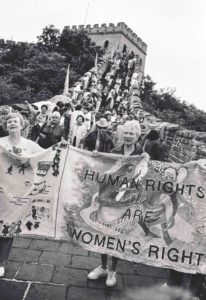
U.N. Fourth World Conference of Women, Beijing, 1995
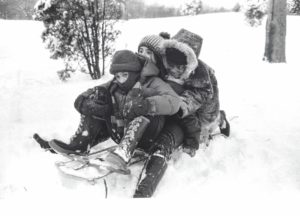
After school busing, friendships developed, 1974

Sonia Sofia Mary Ellen Barbara and her personal treasures. NYC, 1974
This wasn’t the life Roth intended to have when she was growing up in suburban Detroit, and she’s grateful for all the twists that brought her to this moment.
The youngest of three siblings, she’s the daughter of a dentist born in Ukraine who immigrated to the U.S., and a mother who grew up in Detroit. A homemaker who invented things, including the first hair curler of its kind, made of rubber and then from cork (patented), Roth’s mother kept a kosher, observant home Roth’s father attended synagogue regularly, her mother less so. “She would just lift up the window and talk to God.” Some of that same intimate spirituality rests in her daughter Joan, too.
Roth, who attended public schools and Hebrew school, recalls, “I wanted to be something. But I didn’t know what.”
She thought about going into theater, and after a year of college she moved to New York to join her boyfriend, Jac Roth, with a hope of attending the New York Academy of Dramatic Arts. She lived at the Barbizon Hotel for Women until her parents insisted that she get married or return to Detroit. At 20, she chose marriage. Her new husband, a businessman, preferred that she be at home. She was happy, she says, and gave up on her theatrical aspirations.
They had two daughters, Melanie and Alison, a home on Manhattan’s Upper East Side, and a house in the Hamptons. Then Roth attended her first women’s conscience-raising group, and the unfolding of a new life began. She recalls group members asking her why she smiled all the time, and why she didn’t “do anything.”
“I think I wanted to do something for myself. My ex-husband didn’t like that. It wasn’t in our contract,” she says.
In the early 1970s, she began working for a commercial photographer. A MoMA exhibition of photographs by Diane Arbus, and the wide emotional range of Arbus’s images, changed her life. She sought out photographer Lisette Model, whose highly valued master class in New York City Arbus had attended. Roth showed up with what she describes as a “terrible portfolio,” but Model allowed her to join. She learned important lessons of street photography from Model, as well as lessons for life.
“Never think you are so good.” “Don’t take work for money; the work will be mediocre,” Model insisted. “It’s easier to do something than to try to do something.” And, to Roth herself, who was then in her late 20s: “Wake up before you miss the rest of your life.”
She also studied with photographer and master printer Sid Kaplan, who printed for Robert Frank, Cornell Capa and others, and worked in Kaplan’s darkroom. Now a close friend, Kaplan has been printing Roth’s photos for decades.
In 1971, she and Jac Roth divorced. To help support herself and her young daughters, she sometimes photographed weddings and bar mitzvahs, but most of her work grew out of her own pursuits, twinning photography and social justice.
“I used to be afraid to go anywhere myself,” she says. “The camera is an entrée into the world.”

Accompanying the Hasidic bride to the wedding canopy, Brooklyn, 1980s

Actress Maia Morgenstern, wearing a fake arm culled from possessions of the dead, in a play about the Vilna ghetto at the Romanian National Theater, 1993
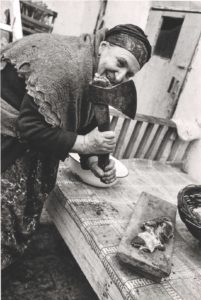
Zoli Kivono Simkevoah, the best caterer in Bukhara, 1991

Jewish women were the potters in Ethiopia, and open hands on handmade earthen storage bins symbolize blessings of the priests, 1984

Devorah, an Israeli from Chile, with timbrel, singing with women who sail down Lake Kinneret annually seeking the biblical Miriam’s Well
As she was beginning her photographic career, Roth moved her daughters from a private kindergarten (where they went to class with the daughters of Dustin Hoffman and Joel Grey) to the local public school. Then she teamed up with a close friend and others to integrate Public School 190. Her friend’s daughter is now making a film, “Bakery Days,” named for their meetings every morning at the L & H Bakery, where they planned their revolutionary work.
In the worlds she captures with her camera, Roth quickly becomes an insider. She doesn’t step out of the story. While she’s not in the picture, she’s grounded in the lives she is documenting.
The first time she met a woman with no housing was on the street across from her apartment building on the Upper East Side; before that, she’d never realized that there were women who had no homes. Sonia Sofia Mary Ellen Barbara, as she introduced herself, with her clothing held together with safety pins, was Jewish. Roth brought her food and money, and would speak to her and others who began congregating there—before the building installed spiked railings on the ledges so they couldn’t sit. With their consent, she took photographs. (Lisette Model was adamant about asking people for permission before taking their picture, a practice Roth follows.)
“I was shocked. I wanted to know who these women were, how they got here.” She admits, “I was afraid that I too might end up homeless.”
Roth probed, and learned that the city’s sole women’s shelter had only 47 beds. With a small grant, she investigated further and wrote a report on homeless women for the Manhattan Bowery Project, including her photographs. A few city officials became interested in the women’s plight, enlisting Roth as part of a new task force. Ultimately the city expanded its facilities and services for homeless women, and in 1977, Roth published some of her black-and-white photos of women who lived on the streets, along with their stories, in an article for Ms. titled, “If I’m not on my milk crate, you can find me in my phone booth.”
Her photos show the women in doorways or pushing carts filled with their belongings; a few are asleep and some smile at the photographer. A collection of those photographs appeared in Roth’s 1982 book, The Shopping Bag Ladies of New York and some, which open up these women’s worlds to viewers who had previously looked away, are in the permanent collections of the Brooklyn Museum and the Museum of the City of New-York.
Harriet Lyons, one of the original editors of Ms., who worked closely with Roth, explains, “Joan had a very personal connection to this population. She was definitely on the front lines, using her talents, which are prodigious as a photographer, to create awareness and support for women’s issues and expose discrimination and all the obstacles that women faced.”
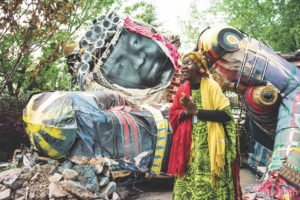
Queen Mother Dr. Delois Blakely at the statue honoring her work to end homelessness, Socrates Sculpture Park, NYC, 2014.

Columbus Circle, NYC, November 7, 2020, spontaneous celebration after the U.S. presidential election was called for Joe Biden.
In 1978, Roth began her work for Lilith. Over the years, she has captured for Lilith’s pages Justice Ruth Bader Ginsberg in her chambers, Israeli feminist pioneer Alice Shalvi, Yiddish theater grand dame Mina Bern, Dr. Ruth Westheimer, and many others who’ve appeared on Lilith’s covers.
After her divorce, Roth was drawn to Jewish life and observance again as she had been while growing up. When she discovered the Carlebach Shul, that became her spiritual home. Then, at a 1984 Shabbat dinner with friends from the congregation, someone mentioned having been on a mission to help the Jews of Ethiopia. In that moment, Roth says, she knew she would travel there, launching a 12-year odyssey in which she made more than 40 visits to document Jewish women around the world.
“Jewish women are so extraordinary. There’s no end to the extraordinariness,” she says.
She claims there’s some spark of mutual recognition when she meets another Jewish woman. The landscapes and faces in her Ethiopian photos look biblical, with one woman making an earthen jug, another dipping her pitcher into water to serve others, and an elder peeking into a synagogue, which she is not allowed to enter. A striking trio wrapped in layers of fabric hold umbrellas to protect them from the sun, a rare sign of modernity. As is Roth’s way, she later connected with many of these women in Israel, and some when they visited New York.
In the early 1980s, anthropologist Morrie Fred helped arrange a show of the Ethiopian photographs at Stockholm’s Museum of Ethnography, its first major exhibition on a Jewish subject. When Fred returned to Chicago as director of the Spertus Museum, he showed Roth’s Ethiopian work in a 1991 joint program with the DuSable Museum of African-American Art.
“The humanity of Joan, which comes through in her photographs and in the meticulous exhibition labels she wrote, is quite remarkable, and unique,” says Fred, who is now a retired professor of anthropology at the University of Chicago (and also one of Roth’s ever-expanding circle of friends who accompany her on adventures when visiting New York). The Ethiopian photos have been exhibited at The Jewish Museum in New York, the Schomburg Center for Research in Black Culture, and in Israel.
To flip through the pages of her 1995 book, Jewish Women: A World of Tradition and Change, is to be surrounded with the faces of women Roth befriended in Yemen, India, Morocco, Russia, Ukraine, Eastern Europe, Bukhara and Israel as well as Ethiopia. She captures emotion in an image and its description, like the longing of an Indian movie actor who struggles between her Jewishness and fame. The centerfold opens to a wide spread of candles, with women alone and in groups lighting, blessing, reflecting. This spectacular volume, which also inspired many exhibitions, is a tribute to Roth’s strength and vision.
Gloria Steinem has said that “Joan Roth has looked at the Jewish world as if women mattered—and therefore as if everyone mattered. Across all boundaries of geography and language, there is not only a common world of belief, but also a common world of women. We see into its intimacy through her eyes.”
Roth seems to fall in love with her subjects, even as she doesn’t like to call them subjects; she prefers to call them her teachers. They are her intimates, sisters in spirit. In Ethiopia and Yemen, she traveled without a translator. “The camera was a language between us.”
When I ask about her ability to gain the trust of the people she photographs, she says, “That’s what I do better than photography. It’s something innate,” she adds. “I really care about them. I don’t have a formula. I want to share their lives and share that with the world.”
Back in New York, friends introduced Roth to Leonard Sanders, and they married in 1998. Together, they tried to help a pair of homeless women, Maggie and Marcia, living in Central Park, and eventually helped Maggie (after Marcia left the Park with her boyfriend) move into an apartment they helped subsidize. Sanders died in 2011, after a long illness.
Roth has lived in the same apartment for more than 55 years. Her daughters, Melanie Roth Gorelick and Alison Zingale, describe life after their parents divorced and Joan pushed ahead with her photography, “giving up material interests to follow her art,” as Melanie recalls.
The family lived modestly, with the girls relying on scholarships for camp and other activities, and working after school as they got older. “Still, my mother didn’t give up on helping others,” Alison says.
Theirs was a childhood of attending women’s marches, and they’d be greeted on their way home from school by the homeless women on their block who’d ask after their mother. Years later, Maggie was a guest at Melanie’s wedding.
“I tell my children,” Melanie says, “that I didn’t get to be a doctor or lawyer. I had to be a soldier for social justice.” Melanie is now Senior Vice President of the Jewish Council for Public Affairs. Among her successes is launching anti-trafficking efforts in the Jewish community. Alison, a social worker, thinks of her mother as “a non-degreed social worker.” She says that their mother was a free spirit, always thinking out of the box. She once turned their kitchen into a darkroom, and when it went back to being a kitchen had a graffiti artist paint the walls. But kitchen or not, Joan rarely cooks, and the family relied on take-out and local diners. Many of the people in her photographs became their guests.




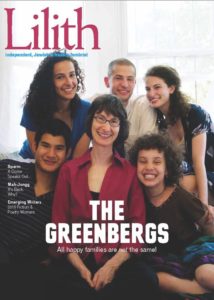
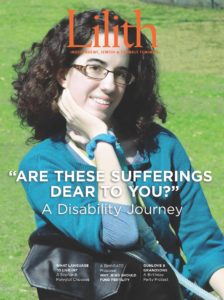


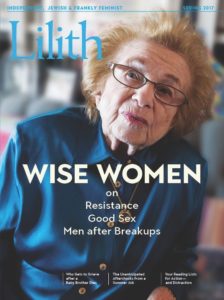

Shira, the oldest of Roth’s four grandchildren, sees her grandmother as mentor and friend. “She gave me a toolkit and vocabulary by which to speak about the world and about feminism,” she says. “I learned from her to follow my passion, go the extra mile and stay curious.
“She is fun and lively and engaged. She takes what needs to be taken seriously very seriously, like human dignity and issues of social justice—and can laugh at herself.”
Roth and her camera have become fixtures at certain kinds of Jewish events, such as those for the Jewish Women’s Archive, JOFA, Project Kesher, the Hadassah Brandeis Institute, “whether at galas, or doing a shoot for Lilith at a women’s march or feminist conference,” according to Lilith’s editor-in-chief, Susan Weidman Schneider.
“Her subjects always feel very special,” she continues. “From behind her camera she keeps up a steady stream of encouragement and compliments which never sound insincere. The subject believes them too: “You’re gorgeous.” “So wonderful.” “Really beautiful.”
These days, with the pandemic, Roth is at home more, spending time organizing her many thousands of photographs. Still, she can’t resist heading to a rally or protest or interesting gathering, always with her camera. Shira, who shares her grandmother’s adventurous spirit, says that they recently went to Chinatown together, a place Roth loves—she loves many things in her life with ferocity—for its busy streets, herb shops and alternative medicine practitioners.
Her advocacy continues as she helps her friend, Queen Mother Dr. Delois Blakely, a former nun known as Ambassador of Goodwill to Africa and named Community Mayor of Harlem, to avoid eviction from the home where she has lived with her disabled daughter since 1982. Queen Mother says Roth is “helping every step of the way” to fight predatory lending and mortgage fraud and help her keep her home.
“She fights injustice wherever she finds it,” says feminist philanthropist Sheri Sandler of Roth. “Her work and her life are so integrated.” Sandler, herself involved in the arts and social justice and the director of a family foundation focusing on girls’ and women’s issues, adds, “Joan is absolutely the most extraordinary friend.”
Not all of Roth’s efforts to help have been appreciated, and sometimes those she meets need more help than she is capable of providing. She says that occasionally people she encounters through her photography and advocacy get angry at her, and “the same door that opens can close.” A woman who appreciates complexities, she accepts how situations unfold.
Several people echoed Morrie Fred’s belief that Roth deserves a major museum retrospective. Confident in her work, she has often been too busy getting on with her next project to promote herself. Over the years, Jewish communal funds were granted to other photographers documenting Jewish communities, but not Roth. The lack of support disappointed her, but never stopped her.
As she explains, without bitterness, “I wasn’t a good fighter for myself in those days. I could fight for other women. I always believed in myself and I just kept going.
“I just always feel that God helps me and is there for me,” Roth says. “I hope that I’m right.”
She’s a person who hates to say goodbye to others; she doesn’t want her connections to the people she has met to end. Her timeless photographs allow her to visualize and remember all those who have landed in her big heart.
Sandee Brawarsky, an award-winning journalist and editor, is the culture editor of The Jewish Week and author of several books, most recently 212 Views of Central Park: Viewing New York City’s Jewel from Every Angle.
- No Comments
 Please wait...
Please wait...